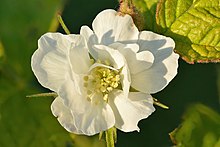Dewberry
This article needs additional citations for verification. (September 2011) |



The dewberries are a group of species in the genus Rubus, section Rubus, closely related to the blackberries. They are small trailing (rather than upright or high-arching) brambles with aggregate fruits, reminiscent of the raspberry, but are usually purple to black instead of red. Unlike many other Rubus species, dewberries have separate male and female plants (they are dioecious).[1]
Dewberries are common throughout most of the Northern Hemisphere, sometimes thought of as a nuisance weed, but the leaves can be used for a tea, and the berries are sweet and edible. They can be eaten raw, or used to make cobbler, jam, or pie.
Around March and April, the plants start to grow white flowers that develop into small green berries. The tiny green berries grow red and then a deep purple-blue as they ripen. When the berries are ripe, they are tender and difficult to pick in any quantity without squashing them. The plants do not have upright canes like some other Rubus species, but have stems that trail along the ground, putting forth new roots along the length of the stem. The stems are covered with fine spines or stickers. The berries are sweet and, for many, less seedy than blackberries and worth the scratches and stains that come from picking them.
In the winter the leaves often remain on the stems, but may turn dark red. The leaves are sometimes eaten by the larvae of some Lepidoptera species including peach blossom moths.
The European dewberry, Rubus caesius, grows more upright like other brambles, but is frequently restricted to coastal communities, especially sand dune systems. Its fruits are a deep, almost black, purple and are coated with a thin layer or 'dew' of waxy droplets. Thus, they appear sky-blue (caesius is Latin for pale blue). It is less sought after, because its fruits are small and retain a markedly tart taste even when fully ripe.
In the late 19th and early 20th centuries, the town of Cameron, North Carolina was known as the "dewberry capital of the world" for large scale cultivation of this berry which was shipped out for wide spread consumption. Local growers made extensive use of the railroads, in the area, to ship them national and internationally.

Species
- Rubus Section Caesii, European dewberry
- European dewberry, Rubus caesius L.
- Rubus Section Flagellares, American dewberries
- Rubus aboriginum Rydb., synonyms:[2]
- Rubus almus (L.H. Bailey) L.H.Bailey
- Rubus austrinus L.H.Bailey
- Rubus bollianus L.H.Bailey
- Rubus clair-brownii' L.H.Bailey
- Rubus decor L.H. Bailey
- Rubus flagellaris Willd. var. almus L.H.Bailey
- Rubus foliaceus L.H. Bailey
- Rubus ignarus L.H. Bailey
- Rubus ricei L.H. Bailey
- Aberdeen dewberry, Rubus depavitus L.H.Bailey
- Northern dewberry, Rubus flagellaris Willd.
- Swamp dewberry, Rubus hispidus L.
- Upland dewberry, Rubus invisus (L.H.Bailey) Britton
- Pacific blackberry, Rubus ursinus Cham. & Schltdl.
- Rubus aboriginum Rydb., synonyms:[2]
See also
- Cloudberry, another dioecious Rubus species
- Youngberry
- List of early spring flowers
- Black raspberry
- Boysenberry, a cross between a dewberry and a Loganberry
References
- ^ Burbank, Luther (1914). Luther Burbank: His Methods and Discoveries, Their Practical Application. Vol. 3. Luther Burbank Press.
- ^ UDSA PLANTS

